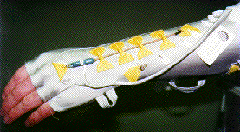
Rubbery Rulers will measure how space men move under zero gravity

The sensors are key elements in skin-tight, instrumented stretch suits to be worn by cosmonauts on experiments aboard Russia's Mir space station.

An all-new type of transducer, the sensors are slim, light and tough, with an elastomer body and a double helix conductive core. Physically they can extend to more than twice their design length. Electrically they convert dimensional changes into current variations to provide data output.
ESA scientists first saw the Melbourne-developed sensor, dubbed the "rubbery ruler", in a 1994 re-run of the science TV series Beyond 2000.
The rubbery ruler was just what the ESA needed. Agency studies of how weightlessness affects human movement put such stringent demands on the means of measurement that no sensors then tested had proved satisfactory.
With the new sensor meeting ESA requirements for lightness, range, flexibility, durability and accuracy, the research is back on track.
The Agency is revolutionising techniques for monitoring space crew activity and aims to develop significant design improvements in space vehicles and equipment.

Coincidentally, it was a human measurement research enquiry that led them to develop the concept more than five years ago. Medicos wanted a device to monitor male erections in impotence research. About 100 other applications in biomedicine and industry have followed. "The very moment the prototype became available every sort of measurement came to mind," says Dr Cimmino.
"It has been used to measure tree growth in forests and the rate of growth of fruit under different levels of irrigation in orchards. It has also been used in monitoring movement in foundations and ground faults, as a secutiry device to indicate window and door positioning, and as an input transducer to virtual reality games.
"It is particularly useful whenever extension, contraction or other movements are to be directly or remotely measured or monitored, especially in hostile environments, tight spaces or over long periods."
He says the sensors, known as extensometers, can handle rough treatment, are unaffected by weather, cost little to make in quantity and can be produced in any length from centimetres to tens of metres.
The University has patented the technology worldwide and so far has signed two commercial licensees, one in medicine and the other in engineering.
![]() School of Physics Inventions Home Page
School of Physics Inventions Home Page